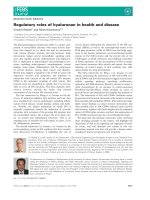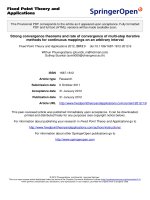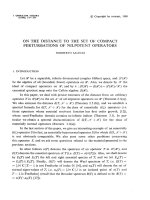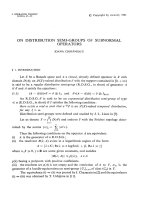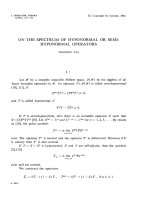Báo cáo toán học: "On Convergence of Two-Parameter Multivalued Pramarts and Mils" ppt
Bạn đang xem bản rút gọn của tài liệu. Xem và tải ngay bản đầy đủ của tài liệu tại đây (126.3 KB, 9 trang )
Vietnam Journal of Mathematics 34:1 (2006) 31–39
On Convergence of Two-Parameter
Multivalued Pramarts and Mils
Vu Viet Ye n
Dept. of Math., Hanoi University of Education, 136 Xuan Thuy Road
Cau Giay Dist., Hanoi, Vietnam
Received No vember 01, 2004
Revised February 05, 2005
Abstract. In this paper we give some convergence results for two-parameter multi-
valued 1-pramarts and 1-mils.
1. Introduction
Real-valued martingales were first introduced and considered by Doob [6], and
later systematically extended to the Banach space-valued case by many authors.
For the main convergence results for vector-valued martingales and their gener-
alizations, the interested reader is referred to Neveu [14], Millet and Sucheston
[12], Talagrand [16], Edgar and Sucheston [5], Luu [9] and etc On the other
hand, martingales, submartingales and laws of large numbers of random sets
have been also extensively considered in recent years by Mosco [13], Castaing
and Valadier [2], Luu [10, 11], Hess [6], Wang and Xue [17], Choukairi - Dini [3],
Wenlong and Zhenpend [18], Lavie [8] and etc The main aim of the note is to
apply some of these results to prove several convergence theorems for multivalued
1-pramarts and 1-mils.
2. Notations and Definitions
Throuthout the paper, we shall denote by (Ω, F, P) a complete probabitity space,
X a separable (real) Banach space and wkc(X) the collection of all nonempty,
weakly compact and convex subsets of X. Further, let denote by N the set of all
32 Vu Viet Yen
nonnegative integers and J = N × N. Then it is known that endowed with the
usual partial order “”, given by s =(s
1
,s
2
) t =(t
1
,t
2
) if and only if s
1
t
1
and s
2
t
2
, J becomes a directed set. Let (F
t
)
t∈J
be a complete stochastic
basis of (Ω, F, P), i.e, a nondecreasing family of complete sub-fields of F with
F =
t∈J
F
t
.Foreacht =(t
1
,t
2
) ∈ J, we put
F
1
t
=
u∈N
F
(t
1
,u)
.
Amapτ :Ω→ J is called an 1-stopping time, if [τ = t] ∈F
1
t
,t∈ J.The
set of all simple 1-stopping times is denoted by T
1
. Then it is also known that
equipped with the a.s. order “”, given by
σ τ if and only if σ(ω) τ (ω), a.s.,
T
1
becomes also a directed set, and N = {n =(n, n),n∈ N} and J would be
regarded as two special cofinal subsets of T
1
. Furthermore, by Proposition 4.2.5
[4], the stochastic basis (F
1
t
)
t∈T
satisfies the Vitalli condition (V), i.e., for any
A ∈F= σ
t
F
1
t
,A
t
∈F
1
t
with A ⊂ esslim sup
t∈J
A
t
and >0, there is a finite
system {t
i
,i m} of J and disjoint sets (B
i
)witheachB
i
∈F
1
t
i
,B
i
⊂ A
t
i
,i
m andsuchthatP
A\
im
B
i
<.
Now let A, C, A
t
∈ wkc(X),t∈ J.Wesaythat(A
t
)
t∈J
is weakly convergent
to A,write
A
t
w
−→ A, t ∈ J,
if for each x
∗
∈ X
∗
,wehave
s(x
∗
,A
t
) → s(x
∗
,A),t∈ J,
where X
∗
is the topological dual of X and
s(x
∗
,C)=sup{<x
∗
,x >, x∈ C}.
Further, (A
t
)
t∈J
is said to be Wijsman c onvergent to A,write
A
t
Wijs
−→ A, t ∈ J,
if for each x ∈ X,wehave
d(x, A
t
) → d(x, A),t∈ J,
where
d(x, C)=inf{x − y,y ∈ C}.
In the particular case, when
A
t
w
−→ A and A
t
Wijs
−→ A, t ∈ J,
we shall say that (A
t
)
t∈J
converges to A in linear topology and write τ
L
- lim
t∈J
A
t
=
A or
On Convergence of Two-Parameter Multivalued Pramarts and Mils 33
A
t
τ
L
−→ A, t ∈ J.
Now, we define
s- lim inf
t∈J
A
t
= {x ∈ X : lim
t∈J
d(x, A
t
)=0}
and
w- lim sup
t∈J
=
x ∈ X : x
k
w
−→ x, x
k
∈ A
t
k
where (t
k
)
k∈N
is a cofinal subsequence of J . Finally, (A
t
)
t∈J
is said to be con-
vergent to A in the Mosco sense,writeM - lim
t∈J
A
t
= A,if
w- lim sup
t∈J
A
t
= A = s- lim inf
t∈J
A
t
.
It is easily checked that if τ
L
- lim
t∈J
A
t
= A then M - lim
t∈J
A
t
= A (see also Lemma
5.4. [6]).
For other related notations and definitions, the reader is referred to Castaing
and Valadier [2].
3. Main Results
From now on, let L
1
wkc(X)
denote the complete metric space of all integrably
bounded multifunctions F :Ω→ wkc(X) (see [7]). It is clear that if F, G ∈
L
1
wkc(X)
then both real-valued functions
|F |(ω)=sup{x,x∈ F (ω)}
and
h(F, G)(ω)=h(F (ω),G(ω)),ω∈ Ω
are also integrable, where
h(A, C)=max
sup
x∈A
d(x, C), sup
y∈C
d(y, A)
.
Unless otherwise stated, we shall consider in the note only processes (F
t
)
t∈J
in
L
1
wkc(X)
such that each F
t
is F
t
-measurable. Note that the first convergence
result we shall prove is connected with the following notion.
Definition 3.1. We say that (F
t
)
t∈J
is an 1-pr amart, if for every >0,there
is σ
0
∈ T
1
such that
P
h(F
σ
, E(F
τ
|F
1
σ
)) >
<, ∀σ, τ ∈ T
1
,σ
0
σ τ.
Remark 1. It is worth noting that in the case, when (F
t
) satisfies the usual
conditional independence condition F
4
, every real-valued L
1
-bounded martin-
gale (F
t
) is an 1-amart (cf. [5], Remark 9.4.12). This with Theorem 4.2.10 [5]
guarantees that (F
t
) converges a.s., hence it should be an 1-pramart.
34 Vu Viet Yen
The following theorem seems to be the first convergence result for multival-
ued 1-pramarts.
Theorem 3.1. Let ((F
t
)
t∈T
be an 1-pramart such that
a)
co
t
F
t
(ω)
∈ wkc(X), ∀ω ∈ Ω,
b) sup
t∈J
E|F
t
| < ∞.
Then there exists an integrably bounded multifunction F such that
τ
L
- lim
t∈J
F
t
= F a.s
Proof. We denote by D (D
∗
) a countable subset which is dense for the norm
(Mackey) topology in the closed unit ball B (B
∗
)ofX (X
∗
, respectively) and
by D
∗
1
the set of all rational linear combinations of members of D
∗
.
Firstly, because for all x
∗
∈ D
∗
,σ,τ∈ T
1
,σ τ we have
|s(x
∗
,F
σ
) −E(s(x
∗
,F
τ
)|F
1
σ
)| = |s(x
∗
,F
σ
) − s(x
∗
, E(F
τ
|F
1
σ
))|
h(F
σ
, E(F
τ
|F
1
σ
))
and (F
t
)
t∈J
is an 1-pramart, (s(x
∗
,F
t
))
t∈J
is a real 1-pramart. Further, by
Proposition 4.2.5 [5], the stochastic basis (F
1
t
)
t∈J
satisfies the Vitali condition
V and by b), Doob’s condition
sup
t∈J
E|s(x
∗
,F
t
)| ||x
∗
|| sup
t∈J
E|F
t
| < ∞
is satisfied, so by Theorem 4.4 or Theorem 5.1 in [12], the real 1-pramart
(s(x
∗
,F
t
))
t∈J
converges almost surely. Therefore, by Lemma 5.2 [6], there exist
a measurable multifunction F with values in wkc(X) and a negligible subset N
1
such that
lim
t∈J
s(x
∗
,F
t
(ω)) = s(x
∗
,F(ω)), ∀x
∗
∈ D
∗
1
, ∀ω ∈ N
1
.
It follows that
F
t
(ω)
w
−→ F (ω),t∈ J, ω ∈ N
1
. (3.1)
Secondly we prove that (F
t
)
t∈J
is Wijsman convergent to F (a.s.). For the
purpose, let us fix x ∈ X, and put
Z
x
∗
t
=<x
∗
,x> −s(x
∗
,F
t
),x
∗
∈ X
∗
,t∈ J.
We show that the process {(Z
x
∗
t
, F
1
t
)
t∈J
,x
∗
∈ D
∗
} is a uniform sequence of
real-valued pramarts, i.e., for every >0, there exists σ
0
∈ T
1
such that for
every σ, τ ∈ T
1
with σ
0
σ τ,wehave
P[sup
x
∗
∈D
∗
|Z
x
∗
σ
−E(Z
x
∗
τ
|F
1
σ
)| >] <. (3.2)
Indeed, since (F
t
, F
1
t
)
t∈J
is a pramart, hence for each >0, there exists σ
0
∈ T
1
such that for any σ, τ ∈ T
1
,σ
0
σ τ, we have
On Convergence of Two-Parameter Multivalued Pramarts and Mils 35
P[h(F
σ
, E(F
τ
|F
1
σ
)) >] <. (3.3)
On the other hand,
sup
x
∗
∈D
∗
|Z
x
∗
σ
−E(Z
x
∗
τ
|F
1
σ
)| =sup
x
∗
∈D
∗
|E[s(x
∗
,F
τ
)|F
1
σ
) − s(x
∗
,F
1
σ
)|
=sup
x
∗
∈D
∗
|s(x
∗
,F
σ
) − s(x
∗
, E(F
τ
|F
1
σ
)|
h(F
σ
, E(F
τ
|F
1
σ
)). (3.4)
Then (3.3) and (3.4) imply (3.2).
But
sup
t∈J
E(sup
x
∗
∈D
∗
|Z
x
∗
t
|) ||x|| +sup
t∈J
E|F
t
| < ∞,
it follows that for each x
∗
∈ D
∗
(Z
x
∗
t
)
t∈J
converges a.s. to some real integrable
function Z
x
∗
(cf. [12, Theorem 5.1]), R
x
∗
t
=ess inf
σ∈T
1
(t)
(Z
x
∗
σ
|F
1
t
) is finite a.s. and
(R
x
∗
t
, F
1
t
)
t∈J
is a generalized sub-martingale (cf. [12, Proposition 3.3]).
Moreover, we can prove that
sup
τ ∈T
1
(σ)
P(sup
x
∗
∈D
∗
(Z
x
∗
σ
−E(Z
x
∗
τ
|F
1
σ
)) >)=P(sup
x
∗
∈D
∗
(Z
x
∗
σ
− R
x
∗
σ
) >), (3.5)
where T
1
(σ)={τ ∈ T
1
,τ σ}. Indeed, by Proposition 4.1.14 in [5], for each
x
∗
∈ D
∗
we can choose a nondecreasing cofinal sequence (τ
x
∗
n
) ⊂ T
1
(σ)such
that E(Z
x
∗
τ
x
∗
n
|F
1
σ
) ↓ R
x
∗
σ
.Then
esssup
τ ∈T
1
(σ)
P
sup
x
∗
∈D
∗
(Z
x
∗
σ
−E(Z
x
∗
τ
|F
1
σ
)
>)
P
esssup
τ ∈T
1
(σ)
sup
x
∗
∈D
∗
(Z
x
∗
σ
−E(Z
x
∗
τ
|F
1
σ
)) >
= P
sup
x
∗
∈D
∗
esssup
τ ∈T
1
(σ)
(Z
x
∗
σ
−E(Z
x
∗
τ
|F
1
σ
)) >
= P
sup
x
∗
∈D
∗
(Z
x
∗
σ
− R
x
∗
σ
)) >
= P
sup
x
∗
∈D
∗
sup
n
(Z
x
∗
σ
−E(Z
x
∗
τ
x
∗
n
|F
1
σ
)) >
= P
sup
n
(sup
x
∗
∈D
∗
(Z
x
∗
σ
−E(Z
x
∗
τ
x
∗
n
|F
1
σ
)) >
=sup
n
P
sup
x
∗
∈D
∗
(Z
x
∗
σ
−E(Z
x
∗
τ
x
∗
n
|F
1
σ
)) >
esssup
τ ∈T
1
(σ)
P
sup
x
∗
∈D
∗
(Z
x
∗
σ
−E(Z
x
∗
τ
|F
1
σ
)) >
.
Thus, (3.5) is proved.
But Z
x
∗
σ
R
x
∗
σ
, a.s., it follows from Theorem 4.2 [12] that
36 Vu Viet Yen
lim
t∈J
sup
x
∗
∈D
∗
|Z
x
∗
t
− R
x
∗
t
|
=0 a.s.,
and thus for each x
∗
∈ D
∗
, the nets (Z
x
∗
t
)
t∈J
and (R
x
∗
t
)
t∈J
converge almost
surely to the same limit Z
x
∗
Applying the proof of Neveu’s Lemma [15, Lemma V.2.9] for the submartin-
gale (R
x
∗
t
)
t∈J
and Wang-Xue’s Lemma [17, Lemma 2.2] we obtain
lim
t
sup
x
∗
∈D
∗
Z
x
∗
t
(ω)
=sup
x
∗
∈D
∗
lim
t
Z
x
∗
t
(ω)
=sup
x
∗
∈D
∗
Z
x
∗
(ω)
for every x ∈ D and ω ∈ N
x
(P (N
x
)=0). Thus, for each x
∗
∈ D
∗
1
,x∈ D and
ω ∈ [N
1
∪ N
x
]
lim
t∈J
Z
x
∗
t
= lim
t∈J
<x
∗
,x> −s(x
∗
,F
t
(ω))
=<x
∗
,x > −s(x
∗
,F(ω)).
On the other hand, since
d(x, A)= sup
x
∗
∈D
∗
[<x
∗
,x> −s<x
∗
,A >],A∈ wkc(X)
(cf [17, p. 815] or [6, p. 190]), we get
lim
t∈J
d(x, F
t
(ω)) = d(x, F (ω))
for all x ∈ D and ω ∈ N
1
∪ (∪
y∈D
N
y
). Thus, by putting N
0
= N
1
∪ (∪
x∈D
N
x
)
we get
F
t
(ω)
Wijs
−→ F (ω),t∈ J, ω ∈ N
0
.
This with (3.1) implies
τ
L
- lim F
t
(ω)=F (ω) ∀ω ∈ N.
Finally, since
|F (ω)| =sup{||x||; x ∈ F (ω)} =sup{s(x
∗
,F(ω)) : x
∗
∈ D
∗
}
we have
|F (ω)| lim inf
t∈J
|F
t
(ω)|, ∀ω ∈ N
0
.
Hence by Fatou’s Lemma
E|F | lim inf
t∈J
E|F
t
| < ∞.
In other words, F is integrably bounded, it completes the proof.
Related to the constructive results of Talagrand [16] for vector-valued mils,
we propose the following.
Definition 3.2. Let (F
t
)
t∈J
be an adapted sequence of integrably bounded
wkc(X)-valued multifunctions. W e say that (F
t
)
t∈J
is an 1-mil, if (F
t
, F
1
t
)
t∈J
On Convergence of Two-Parameter Multivalued Pramarts and Mils 37
is a mil, i.e., for every >0,thereexistsp ∈ N such that for any n ∈ N,τ∈
T
1
, p τ n, we have
P(h(X
τ
, E(X
n
|F
1
τ
)) >) <,
where
n =(n, n) ∈ N.
Remark 2. It is easy to see that every 1-pramart is an 1-mil. Furthermore,
restricted to the one-parameter discrete case, the notion of 1-mils coincides with
the original notion of mils introduced by Talagrand [16].
The following lemma will be needed in the proof of the next weak convergence
result.
Lemma 3.1. Let (X
t
)
t∈J
be a uniformly integrable, real 1-mil. Then (X
t
)
t∈J
converges a.s.
Proof. Let (X
t
)
t∈J
beasgiveninthelemma. Then(X
n
, F
1
n
)
n0
is also a
mil in the sense of Talagrand. Hence, by ([16, Theorem 4]) and the uniform
integrability of (X
t
)
t∈T
,(X
n
)convergestosomeX a.s. and in L
1
.Consequently
(X
n
)
n∈N
is written uniquely in the form X
n
= Y
n
+Z
n
where (Y
n
)
n∈N
is a regular
martingale: Y
n
= E(X|F
1
n
)and(Z
n
)
n∈N
is a mil with Z
n
→ 0 a.s. and in L
1
,
n ∈ N.
Put Y
t
= E(X|F
1
t
),Z
t
= X
t
− Y
t
,t∈ J. Since (Y
t
, F
1
t
)
t∈J
is a regular
martingale, hence by ([12, Theorem 4.3]), (Y
t
)convergestoX a.s. and in L
1
.
Now we prove that the mil (Z
t
, F
1
t
)
t∈J
is convergent to 0 a.s. By Theorem
4.2 in [12] (see also [19], Lemma 2), it is sufficient to prove that the net (Z
τ
)
τ ∈T
1
converges to 0 in probability. Since (Z
t
, F
1
t
)
t∈J
is a mil, for any >0thereis
p ∈ N such that for every τ ∈ T
1
,n
1
∈ N with p τ n
1
,wehave
P(|Z
τ
−E(Z
n
|F
1
τ
)| >) <. (3.6)
On the other hand, since Z
n
→ 0inL
1
as n ↑∞, it follows that there is
n
2
n
1
,n
2
∈ N such that
E|Z
n
| <
2
,n n
2
. (3.7)
Thus, by (3.6), (3.7) and Chebyshev’s inequality, for any τ ∈ T
1
and n ∈ N
satisfying τ
p, n n
2
,wehave
P(|Z
τ
| > 2) P
Z
τ
−E(Z
n
|F
1
τ
)
>
+ P
E(Z
n
|F
1
τ
)
>
+
E|Z
n
|
+
2
=2.
It means that (Z
τ
)
τ ∈T
1
converges to 0 in probability.
This completes the proof.
For multivalued 1-mils, we get the following weak convergence result.
Theorem 3.2. Let (F
t
,t ∈ N) be a uniformly inte grable wkc(X)-valued 1-mil.
Supp ose that
38 Vu Viet Yen
co
t∈J
F
t
(ω)
∈ wkc(X),ω∈ Ω.
Then there exists a multifunction F of L
1
wkc(X)
such that
w- lim
t∈J
F
t
= Fa.s.
Proof. Let (F
t
)
t∈J
be as given in the theorem. Since for each x
∗
∈ X
∗
|s(x
∗
,F
t
(ω))| ||x
∗
|||F
t
(ω)|,
the set {s(x
∗
,F
t
)}
t∈J
is uniformly integrable.
But if x
∗
1, we have
|s(x
∗
,F
σ
) −E(s(x
∗
,F
n
)|F
1
σ
)|
=
s(x
∗
,F
σ
) − s(x
∗
, E(F
n
|F
1
σ
))
h(F
σ
, E(F
n
|F
1
σ
)) for any σ n,
then for each x
∗
∈ X
∗
, the process {s(x
∗
,F
t
}
t∈J
is also a uniformly integrable
real 1-mil. It follows from Lemma 3.1 that for each x
∗
∈ D
∗
1
there exists a negli-
gible subset N
x
∗
such that lim
t
s(x
∗
,F
t
(ω)) exists for any ω ∈ Ω\N
x
∗
.Thiswith
the same argument used in Lemma 5.2 [6] entails the existence of a multifunction
F with values in wkc(X) which satisfies
s(x
∗
,F(ω)) = lim
t
s(x
∗
,F
t
(ω)), ∀ω ∈ N, ∀x
∗
∈ D
∗
1
where N =
x
∗
∈D
∗
1
N
x
∗
.ButD
∗
1
is countable and dense in X
∗
for the Mackey
topology, it guarantees that
F
t
w
−→ F, t ∈ J.
The proof is thus complete.
References
1. E. Cairoli and J. B. Walsh, Stochastic integrals in the plane, Acta. Math. 134
(1975) 111-183.
2. C. Castaing and M. Valadie, Convex analysis and measurable multifunction, Lec-
ture Notes in Math., Vol. 526, Springer-Verlag, Berlin and New York, 1977.
3. A. Choukairi - Dini, On almost sure convergence of vector valued pramarts and
multivalued pramarts, J. Con. Anal. 3 (1996) 245–254.
4. G. A. Edgar and L. Sucheston, A mart: a class of asymptotic martingales, A.
Discrete parameter, J. Multivaritate Anal. 6 (1976a) 572–591.
5. G. A. Edgar and L. Sucheston, Stoppi ng Times and Directed Processes,Cam-
bridge Univ. Press, 1992.
6. C. Hess, On multivalued martingales whose values may be unbounded: martin-
gale s electors and Mosco- Convergence, J. Mult. Anal. 39 (1991) 175–201.
On Convergence of Two-Parameter Multivalued Pramarts and Mils 39
7. F. Hiai and H. Umegaki, Integrables, conditional expectations and martingales
of multivalued functions, J. Mult. Anal. 7 (1977) 149–182.
8. M. Lavie, On the convergence of multivalued martingales in limit, Monog. Sem.
Mat. Garcia de Galdeano 27 (2003) 3930-398.
9. D. Q. Luu, On further classes of martingale-like sequences and some decomposi-
tion and convergence theorems, Glassgow J. Math. 41 (1999) 313–322.
10. D. Q. Luu, On convergence of multivalued asymptotic martingales, S. A. C.
Montpell ier Expose.
11. D. Q. Luu, Application of set-valued Radon-Nikodym theorems to convergence
of multivalued
L
1
-armarts, Math. Scand. 5 (1984) 101–113.
12. A. Millet and L. Sucheston, Convergence of classes of amart indexed by directed
sets, Canad. J. Math. 32 (1980) 86–125.
13. U. Mosco, Convergence of convex sets and of solutions of variational inequalities,
Adv. in Math. 3 (1969) 510–585.
14. J. Neveu, Convergence presque sur de martingales multivogues, Ann. Inst. Henri
Poincare B8 (1972) 1–7.
15. J. Neveu, Discrete Parameter Martingales, North-Holland, Amsterdam, 1975.
16. M. Talagrand, Some structure results for martingales in limit and pramarts, The
Ann. Prob. 13 (1975).
17. Z. Wang and X. Xue, On convergence and closedness of multivalued martingales,
Trans. Amer. Math. Soc. 341 (1994) 807–827.
18. D. Wenlong and W. Zhenpend, On representation and regularity of continuous
parameter multivalued martingales, Proc. Amer. Math. Soc. 126 (1998) 1799–
1810.
19. V. V. Yen, Strong convergence of two-parameter vector-valued martingales and
martingales in limit, Acta Math. Vietnam. 14 (1989) 59–66.
20. V. V. Yen, On convergence of multiparameter multivalued martingales, Acta
Math. Vietnam. 29 (2004) 177–189.
